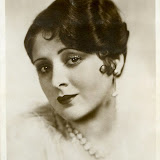“He whose face gives no light shall never become a star.”
William Blake
In 1919 Heinrich Ross, an Austro-Hungarian living in Berlin founded the postcard publishing company, Ross Verlag. Like any decent entrepreneur he could see the stirrings in popular culture before they became fully apparent and he realized that in the future the stars would not belong to opera or the stage but cinema. The film industries in Germany and France and especially Hollywood were emerging and with them new ideas about what glamour, beauty and stardom meant. The Ross Company is credited with publishing some 40 000 postcards, mostly it appears for the German market. Being a publisher, he wasn’t concerned with stage directing the studios, rather he licensed existing photographs. The history is a little obscure as to how much or even whether he invented the particular appearance to his postcards but within a few years the Ross Verlag look – if we can call it that – sepia toned gelatine bromide prints on cream card stock, were being produced in France, Italy, Austria, Turkey, Poland, Sweden and England. Naturally enough they focused on stars from their own countries but, especially where American actors were concerned, all used the same licensed images. In a lot of cases the only difference between cards was the publisher’s stamp at the bottom.
Ross and his competitors were by no means the first to realize the power of actors to sell its product. Half a century earlier the London Stereoscopic Company had been producing cartes de visite of stage and opera stars and encouraging its customers to collect them. There’d been a few changes in the interim, camera technology, the introduction of artificial lighting, but the most important so far as publishers were concerned was that the silent cinema was a global medium. Nobody in England would have been wildly interested in a German stage actress unless she spoke English fluently and appeared in the West End but everyone could watch Metropolis and the Europeans got Charlie Chaplin and Buster Keaton as succinctly as the Americans.
The Ross Company bought images from the film studios and though we know that the work of some significant photographers such as Clarence Bull, George Hurrell and Emile Hoppé appeared on the cards, they were rarely credited. It was also the situation that various film studios developed a particular look for their stars that depended on lighting angles and background. The photographers tended to work within tight guidelines. The film studio was a place for manufacturing stars and the story of these cards then is really a case study in economics, how a product is created and marketed to the world. Here it isn’t the actors or the cinema but the idea of glamour and sophistication. For the first time these qualities weren’t innate to wealth or position. Even a farm girl could look the epitome of cool elegance if she was photographed the right way.
As his name might indicate, Ross was Jewish and during the 1930s the Nazis took control of Ross Verlag. He left Germany in 1939 and ended up in Chicago, where he died in the 1940s. An exhaustive history of the company including the publishing details of thousands of cards can be found here at www.rosscards.com. The photos in this gallery include Ross cards, of course, but also French and Turkish examples, of actors, beauty queens and Jack Dempsey, who was neither of the above but was at least an iconic symbol of the 1920s.
VIEW THE GALLERY HERE
 |
| STARS |




These are so wonderful. Looking at the group of them I can almost imagine myself as a young girl collecting them. Seeing each for the first time and adoringly adding it to my collection.
ReplyDeleteI'll put another post up in a couple of weeks of Weimar actresses such as Brigitte Helm who was the robot in Metropolis and Lil Dagover who was in The Cabinet of Dr Caligari
ReplyDeleteAnd don't forget to look at the Rosscards homepage. It will tell you all you need to know.
ReplyDelete